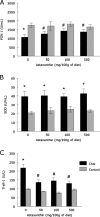Astaxanthin prevents changes in the activities of thioredoxin reductase and paraoxonase in hypercholesterolemic rabbits
- PMID: 22798712
- PMCID: PMC3391862
- DOI: 10.3164/jcbn.11-74
Astaxanthin prevents changes in the activities of thioredoxin reductase and paraoxonase in hypercholesterolemic rabbits
Abstract
This study explored the effects of the antioxidant astaxanthin on paraoxonase and thioredoxin reductase activities as well as on other oxidative stress parameters and on the lipid profile in hypercholesterolemic rabbits. Rabbits were fed a standard or a hypercholesterolemic diet alone or supplemented with 50, 100 and 500 mg/100 g of astaxanthin for 60 days. Antioxidant enzymes activities, lipid profile and oxidative stress markers were evaluated in the serum. The hypercholesterolemic diet increased lipids, including unsaturated fatty acids level, whereas it decreased saturated fatty acids level. These changes were accompanied by increased levels of oxidized low-density lipoprotein and oxidized low-density lipoprotein antibodies, as well as lipid and protein oxidation. Astaxanthin (100 and 500 mg/100 g) prevented hypercholesterolemia-induced protein oxidation, whereas 500 mg/100 g of astaxanthin decreased protein oxidation per se. The activities of superoxide dismutase and thioredoxin reductase were enhanced, whereas paraoxonase activity was inhibited in hypercholesterolemic rabbits. All astaxanthin doses prevented changes in thioredoxin reductase and paraoxonase activities. This effect was not related to a direct effect of astaxanthin on these enzymes, because in vitro astaxanthin enhanced thioredoxin reductase and had no effect on paraoxonase activity. Astaxanthin could be helpful in cardiovascular diseases by restoring thioredoxin reductase and paraoxonase activities.
Keywords: atherosclerosis; fatty acids; oxidative stress.
Figures




Similar articles
-
The antiatherogenic effect of bixin in hypercholesterolemic rabbits is associated to the improvement of lipid profile and to its antioxidant and anti-inflammatory effects.Mol Cell Biochem. 2015 May;403(1-2):243-53. doi: 10.1007/s11010-015-2354-x. Epub 2015 Feb 22. Mol Cell Biochem. 2015. PMID: 25702177
-
Imbalance in superoxide dismutase/thioredoxin reductase activities in hypercholesterolemic subjects: relationship with low density lipoprotein oxidation.Lipids Health Dis. 2012 Jun 21;11:79. doi: 10.1186/1476-511X-11-79. Lipids Health Dis. 2012. PMID: 22721254 Free PMC article.
-
Effect of atorvastatin therapy on oxidant-antioxidant status and atherosclerotic plaque formation.Vasc Health Risk Manag. 2011;7:333-43. doi: 10.2147/VHRM.S17781. Epub 2011 Jun 1. Vasc Health Risk Manag. 2011. PMID: 21731885 Free PMC article.
-
Cardiovascular diseases: oxidative damage and antioxidant protection.Eur Rev Med Pharmacol Sci. 2014 Oct;18(20):3091-6. Eur Rev Med Pharmacol Sci. 2014. PMID: 25392110 Review.
-
Potential Anti-Atherosclerotic Properties of Astaxanthin.Mar Drugs. 2016 Feb 5;14(2):35. doi: 10.3390/md14020035. Mar Drugs. 2016. PMID: 26861359 Free PMC article. Review.
Cited by
-
Effects of astaxanthin on antioxidation in human aqueous humor.J Clin Biochem Nutr. 2013 Jul;53(1):1-7. doi: 10.3164/jcbn.13-6. Epub 2013 May 18. J Clin Biochem Nutr. 2013. PMID: 23874063 Free PMC article.
-
High-fat diet abolishes the cardioprotective effects of ischemic postconditioning in murine models despite increased thioredoxin-1 levels.Mol Cell Biochem. 2019 Feb;452(1-2):153-166. doi: 10.1007/s11010-018-3421-x. Epub 2018 Aug 9. Mol Cell Biochem. 2019. PMID: 30094601
-
Astaxanthin-Producing Green Microalga Haematococcus pluvialis: From Single Cell to High Value Commercial Products.Front Plant Sci. 2016 Apr 28;7:531. doi: 10.3389/fpls.2016.00531. eCollection 2016. Front Plant Sci. 2016. PMID: 27200009 Free PMC article. Review.
-
Effect of Astaxanthin on the Antioxidant Capacity and Intestinal Microbiota of Tsinling Lenok Trout (Brachymystax lenok tsinlingensis).Mar Biotechnol (NY). 2022 Dec;24(6):1125-1137. doi: 10.1007/s10126-022-10175-3. Epub 2022 Nov 3. Mar Biotechnol (NY). 2022. PMID: 36329353
-
Antioxidant and anti‑inflammatory mechanisms of action of astaxanthin in cardiovascular diseases (Review).Int J Mol Med. 2021 Jan;47(1):37-48. doi: 10.3892/ijmm.2020.4783. Epub 2020 Nov 4. Int J Mol Med. 2021. PMID: 33155666 Free PMC article. Review.
References
-
- Kruth HS. Lipoprotein cholesterol and atherosclerosis. Curr Mol Med. 2001;1:633–653. - PubMed
-
- Prasad K, Kalra J. Oxygen free radicals and hypercholesterolemic atherosclerosis: effect of vitamin E. Am Heart J. 1993;125:958–973. - PubMed
-
- Duarte MM, Rocha JB, Moresco RN, et al. Association between ischemia-modified albumin, lipids and inflammation biomarkers in patients with hypercholesterolemia. Clin Biochem. 2009;42:666–671. - PubMed
-
- Berliner JA, Navab M, Fogelman AM, et al. Atherosclerosis: basic mechanisms. Oxidation, inflammation, and genetics. Circulation. 1995;91:2488–2496. - PubMed
-
- Kondo A, Murunaka Y, Ohta I, et al. Relationships between triglyceride concentrations and LDL size evaluated by malonadehyde-modified LDL. Clin Chem. 2001;47:893–900. - PubMed

